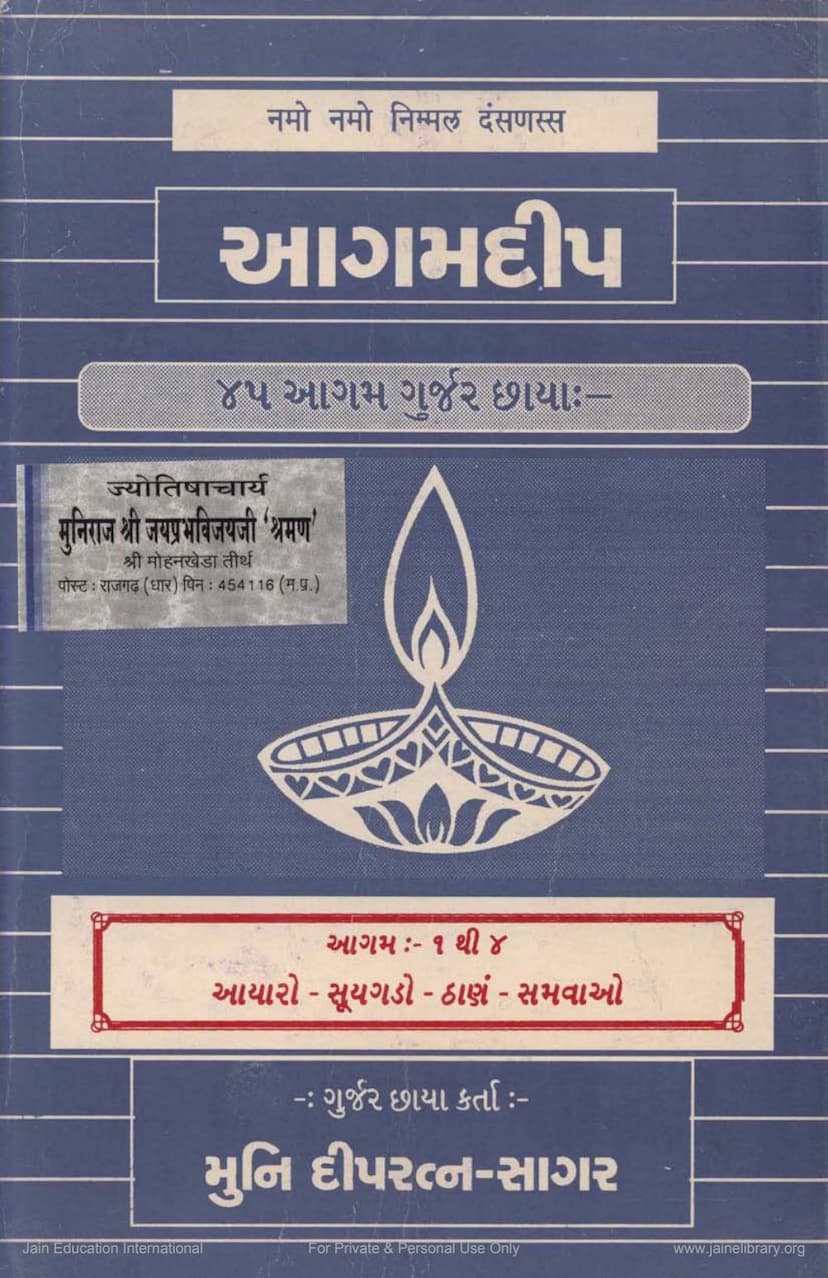Agam Deep 29 Santharagam Gujarati Anuvaad
Added to library: September 1, 2025

Summary
This document is the "Agam Deep 29 Santharagam Gujarati Anuvaad," authored by Dipratnasagar and Deepratnasagar, and published by Agam Shrut Prakashan. It is a Gujarati translation and commentary (Anuvaad and Chhaya) of the Jain Agama text "Santharagam." The publication is part of a larger series called "Agam Deep."
Here's a breakdown of the content based on the provided pages:
Key Information and Structure:
- Title: Agam Deep 29 Santharagam Gujarati Anuvaad
- Author: Dipratnasagar, Deepratnasagar
- Publisher: Agam Shrut Prakashan
- Subject: Santhara (a religious practice of voluntary fasting to the death, often undertaken by ascetics in Jainism). The text provides a Gujarati commentary and explanation.
- Series: Agam Deep (specifically Volume 29).
- Language: Gujarati (Anuvaad/Translation and Chhaya/Commentary).
- Catalog Link: https://jainqq.org/explore/005089/1
- Price: Rs. 2000/- (as indicated for the "Agam Deep 45 Agam Gujarati Chhaya").
- Sponsorship: The publication acknowledges several key financial supporters, primarily the family of Shrimati Naynaben Rameshchandra Shah from Vadodara, along with other individuals and Jain Sanghs from Ahmedabad and elsewhere. This indicates a community effort in publishing religious texts.
Content Summary of "Santharagam" (based on the provided Gujarati text):
The document delves into the concept and practice of "Santhara," highlighting its spiritual significance and the qualities of those who undertake it. The core themes are:
-
The Glorification of Santhara: The text repeatedly emphasizes that Santhara is the highest form of spiritual practice, comparable to the most revered entities in various domains (e.g., the Lion among animals, the Vajra among gems, the Ganges among rivers). It's described as the ultimate aspiration of "suvihit" (well-guided) souls.
-
Santhara as the Pinnacle of Sadhana: It is presented as the culmination of a spiritual life, the ultimate conquest over karma, and the path to liberation (Siddhi). It is considered superior to all other forms of austerity, meditation, and knowledge.
-
Qualities of a Santhara Practitioner: The text meticulously outlines the virtuous qualities required for undertaking Santhara. These include:
- Right Faith (Samyak Darshan): Purity of faith, free from doubts and distortions.
- Right Conduct (Samyak Charitra): Strict adherence to vows, discipline, and the absence of transgressions.
- Absence of Passions (Kashayas): Mastery over anger, pride, deceit, and greed.
- Control over Senses and Mind: Renunciation of worldly desires and mental purity.
- Freedom from Attachments: Detachment from the body and possessions.
- Inner Purity: Absence of pride, ego, and attachment to the body.
- Knowledge and Wisdom: Deep understanding of Jain scriptures and philosophy.
- Renunciation of "Shalyas" (Inner Pains/Defects): Freedom from mental afflictions like doubt, hypocrisy, and false views.
- Acceptance of Suffering: The ability to bear hardships with equanimity.
-
The Process and Significance of Santhara:
- It's a conscious and deliberate act of accepting the end of life, often initiated when one foresees their death approaching.
- It involves renouncing all four types of food (Ahar) and water, according to the guidance of the Guru.
- The ultimate goal is the destruction of karmic bondage and the attainment of liberation (Moksha).
- Even celestial beings (Deities) aspire to achieve this state of "Pandit Maran" (wise death).
-
Examples and Narratives: The text recounts numerous inspirational stories (Gathas 1-121) of Jain monks, nuns, kings, ministers, and laypeople who exemplified the practice of Santhara, often facing extreme adversity, torture, and death, yet maintaining their equanimity and achieving liberation. These examples include:
- Shri Arnika Putra
- The five hundred virtuous monks (Shri Skandak Suri and others) who were crushed to death.
- King Ded of Kulan Kunal.
- Shri Sukeshal Rishi, son of King Kirtidhar.
- Shri Avantisukumar.
- Shri Kartikarya Rishi.
- Dharmasingh, friend of Chandragupta.
- Chanakya.
- King Amritghosh.
- The thirty-two men of Lalitghata.
- Shri Rishabhsena Acharya and Shri Singhsen Upadhyay, who were burned alive.
- Shri Gajsukumar Rishi.
- Disciples of Lord Mahavir, Shri Nakshatra and Shri Sanubhutinath, who were burned by Mankhali Gosala.
-
The Role of the Sangha and Guru: The text emphasizes the importance of the spiritual community (Sangha) and the Guru's guidance in undertaking Santhara. It highlights the need for seeking forgiveness and making amends before death.
-
The Contrast with Worldly Pleasures: The text contrasts the profound and lasting bliss of Santhara and liberation with the fleeting and ultimately painful pleasures of worldly life, even those experienced by kings and deities.
Overall Purpose:
The "Agam Deep 29 Santharagam Gujarati Anuvaad" serves as a guide and inspiration for Jains, particularly ascetics, on the spiritual significance and proper practice of Santhara. It aims to educate readers about the virtues required, the process involved, and the ultimate benefits of this profound religious undertaking, illustrated through compelling historical narratives.